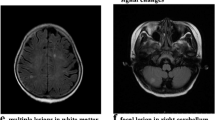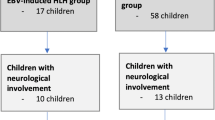Abstract
Objectives
To investigate the association of brain MRI and clinical variables with death in children with central nervous system involvement of hemophagocytic lymphohistiocytosis (CNS-HLH).
Methods
Clinical and brain MRI data of children with CNS-HLH from January 2012 to March 2022 were reviewed retrospectively. Patients were divided into the deceased group and the surviving group. The intergroup differences of seven brain MRI variables, twelve clinical variables, and underlying diseases were studied.
Results
One hundred and fourteen patients were included in this study, consisting of 59 who died and 55 who survived. The included clinical variables did not show statistically independent correlation with patients’ deaths. For MRI variables, a multivariate analysis demonstrated restricted diffusion of lesion (OR = 9.64, 95% CI: 3.39–27.43, p < 0.001) and count of affected brain regions (CABR) (OR = 1.24, 95% CI: 1.03–1.49, p = 0.02) were independent risk factors for death. ROC curve showed CABR (AUC = 0.79, 95% CI: 0.70–0.87, p < 0.001) is highly predictive for mortality with an optimal cutoff value of 4.5 (sensitivity 76%, specificity 73%). For HLH subtypes, familial HLH (F-HLH, OR = 9.90, 95% CI: 2.01–48.87, p = 0.005) and immune-compromise-related HLH (IC-HLH, OR = 4.95, 95% CI: 1.40–17.46, p = 0.01) presented statistically stronger association with death than infection-related HLH. F-HLH and IC-HLH preferred to have large lesions, restricted diffusion, and more brain regions involved than other subtypes.
Conclusion
Brain MRI features exhibit independent prediction for mortality in children with CNS-HLH, and HLH subtypes pose effects on patient outcomes and brain MRI findings.
Clinical relevance statement
The number of affected brain regions and diffusion restriction of lesion exhibit significant correlation with mortality in children diagnosed with CNS-hemophagocytic lymphohistiocytosis, and may serve as candidate MRI markers for the prediction of the disorder’s severity.
Key Points
• The brain MRI markers, restricted diffusion of lesion and count of affected brain regions, significantly correlated with death.
• Familial and immune-compromise-related hemophagocytic lymphohistiocytosis presented statistically stronger association with death than infection-related subtype.
• Brain MRI is potential in death-predicting for children with central nervous system involvement of hemophagocytic lymphohistiocytosis.





Similar content being viewed by others
Abbreviations
- ADC:
-
Apparent diffusion coefficient
- CNS:
-
Central nervous system
- CSF:
-
Cerebrospinal fluid
- DPVL:
-
Diffuse parenchymal volume loss
- DWI:
-
Diffusion-weighted imaging
- HLH:
-
Hemophagocytic lymphohistiocytosis
- F-HLH:
-
Familial hemophagocytic lymphohistiocytosis
- I-HLH:
-
Infection-related hemophagocytic lymphohistiocytosis
- IC-HLH:
-
Immune-compromise-related hemophagocytic lymphohistiocytosis
- MRI:
-
Magnetic resonance imaging
- R-HLH:
-
Rheumatological hemophagocytic lymphohistiocytosis
- SI:
-
Signal intensity
References
Horne AC, Wickstrom R, Jordan MB et al (2017) How to treat involvement of the central nervous system in hemophagocytic lymphohistiocytosis? Curr Treat Options in Neurol 19:3
Chuang HC, Lay JD, Hsieh WC, Su IJ (2007) Pathogenesis and mechanism of disease progression from hemophagocytic lymphohistiocytosis to Epstein-Barr virus-associated T-cell lymphoma: nuclear factor-kappa B pathway as a potential therapeutic target. Cancer Sci 98:1281–1287
Molleran Lee S, Villanueva J, Sumegi J et al (2004) Characterisation of diverse PRF1 mutations leading to decreased natural killer cell activity in North American families with haemophagocytic lymphohistiocytosis. J Med Genet 41:137–144
Haddad E, Sulis ML, Jabado N, Blanche S, Fischer A, Tardieu M (1997) Frequency and severity of central nervous system lesions in hemophagocytic lymphohistiocytosis. Blood 89:794–800
Deiva K, Mahlaoui N, Beaudonnet F et al (2012) CNS involvement at the onset of primary hemophagocytic lymphohistiocytosis. Neurology 78:1150–1156
Wen FY, Xiao L, Liao ML et al (2018) Clinical features and prognosis of central nervous system involvement in patients with Epstein-Barr virus associated hemophagocytic lymphohistiocytosis. J Chin J Appl Clin Pediatr 33:453–457. https://doi.org/10.3760/cma.j.issn.2095-428X.2018.06.014
Wen FY, Xiao L, Xian Y et al (2017) Prognosis of the central nervous system involvement in patients with hemophagocytic lymphohistiocytosis. Chin J Hematol 38:848–852. https://doi.org/10.3760/cma.j.issn.0253-2727.2017.10.005
Kim MM, Yum MS, Choi HW et al (2012) Central nervous system (CNS) involvement is a critical prognostic factor for hemophagocytic lymphohistiocytosis. Korean J Hematol 47:273–280
Zhao YZ, Zhang Q, Li ZG et al (2018) Central nervous system involvement in 179 Chinese children with hemophagocytic lymphohistiocytosis. Chin Med J (Engl) 131:1786–1792
Yang S, Zhang L, Jia C, Ma H, Henter JI, Shen K (2010) Frequency and development of CNS involvement in Chinese children with hemophagocytic lymphohistiocytosis. Pediatr Blood Cancer 54:408–415
Ma W, Li XJ, Li W, Xiao L, Ji XJ, Xu Y (2021) MRI findings of central nervous system involvement in children with haemophagocytic lymphohistiocytosis: correlation with clinical biochemical tests. Clin Radiol 76:159.e9-159.e17
Henter JI, Horne A, Aricó M et al (2007) HLH-2004: diagnostic and therapeutic guidelines for hemophagocytic lymphohistiocytosis. Pediatr Blood Cancer 48:124–131
China Expert Alliance on Hemophagocytic Syndrome and Hematology Group of the Society of Pediatrics CM Association (2018) Chinese expert consensus on diagnosis and treatment of hemophagocytic syndrome. Chin Med J (cn) 98:91–95. https://doi.org/10.3760/cma.j.issn.0376-2491.2018.02.004
Zecca C, Cereda C, Wetzel S et al (2012) Diffusion-weighted imaging in acute demyelinating myelopathy. Neuroradiology 54:573–578
Oren NC, Chang E, Yang CW, Lee SK (2019) Brain diffusion imaging findings may predict clinical outcome after cardiac arrest. J Neuroimaging 29:540–547
Jordan MB, Allen CE, Greenberg J et al (2019) Challenges in the diagnosis of hemophagocytic lymphohistiocytosis: recommendations from the North American Consortium for Histiocytosis (NACHO). Pediatr Blood Cancer 66:e27929
Imashuku S, Hyakuna N, Funabiki T et al (2002) Low natural killer activity and central nervous system disease as a high-risk prognostic indicator in young patients with hemophagocytic lymphohistiocytosis. Cancer 94:3023–3031
Parida A, Abdel-Mannan O, Mankad K et al (2022) Isolated central nervous system familial hemophagocytic lymphohistiocytosis (fHLH) presenting as a mimic of demyelination in children. Mult Scler 28:669–675
Chong KW, Lee JH, Choong CT et al (2012) Hemophagocytic lymphohistiocytosis with isolated central nervous system reactivation and optic nerve involvement. J Child Neurol 27:1336–1339
Ou W, Zhao Y, Wei A et al (2023) Chronic active Epstein-Barr virus infection with central nervous system involvement in children: a clinical study of 22 cases. Pediatr Infect Dis J 42:20–26
Goo HW, Weon YC (2007) A spectrum of neuroradiological findings in children with haemophagocytic lymphohistiocytosis. Pediatr Radiol 37:1110–1117
Trottestam H, Horne A, Arico M et al (2011) Chemoimmunotherapy for hemophagocytic lymphohistiocytosis: long-term results of the HLH-94 treatment protocol. Blood 118:4577–4584
Oguz MM, Sahin G, AltinelAcoglu E et al (2019) Secondary hemophagocytic lymphohistiocytosis in pediatric patients: a single center experience and factors that influenced patient prognosis. Pediatr Hematol Oncol 36:1–16
Koh KN, Im HJ, Chung NG et al (2015) Clinical features, genetics, and outcome of pediatric patients with hemophagocytic lymphohistiocytosis in Korea: report of a nationwide survey from Korea Histiocytosis Working Party. Eur J Haematol 94:51–59
Tang YM, Luo Z (2018) Prognostic factors of early death in children with hemophagocytic lymphohistiocytosis. Cytokine 110:481–482
Huang J, Yin G, Duan L et al (2020) Prognostic value of blood-based inflammatory biomarkers in secondary hemophagocytic ymphohistiocytosis. J Clin Immunol 40:718–728
Song Y, Pei RJ, Wang YN, Zhang J, Wang Z (2018) Central nervous system involvement in hemophagocytic lymphohistiocytosis in adults: a retrospective analysis of 96 patients in a single center. Chin Med J (Engl) 131:776–783
Chung TW (2007) CNS involvement in hemophagocytic lymphohistiocytosis: CT and MR findings. Korean J Radiol 8:78–81
Guandalini M, Butler A, Mandelstam S (2014) Spectrum of imaging appearances in Australian children with central nervous system hemophagocytic lymphohistiocytosis. J Clin Neurosci 21:305–310
Decaminada N, Cappellini M, Mortilla M et al (2010) Familial hemophagocytic lymphohistiocytosis: clinical and neuroradiological findings and review of the literature. Childs Nerv Syst 26:121–127
Faitelson Y, Grunebaum E (2014) Hemophagocytic lymphohistiocytosis and primary immune deficiency disorders. Clin Immunol 155:118–125
Marc T, Kevin R (2013) Neurological expression of genetic immunodeficiencies and of opportunistic infections. Handb Clin Neurol 112:1219–1227
Canna SW, Marsh RA (2020) Pediatric hemophagocytic lymphohistiocytosis. Blood 135:1332–1343
Funding
This study has received funding from the National Natural Science Foundation of China (81301300), Chongqing Science and Technology Foundation, and Chongqing Science and Technology Commission (cstc2018jscx-msybX0069 and cstc2016 shmszx130009).
Author information
Authors and Affiliations
Corresponding author
Ethics declarations
Guarantor
The scientific guarantor of this publication is Ye Xu, email: yexu@cqmu.edu.cn., address: Department of Radiology, Children’s Hospital of Chongqing Medical University, 136 Zhongshan Er Lu, Yuzhong District, Chongqing 400000, China.
Conflict of interest
The authors of this manuscript declare no relationships with any companies, whose products or services may be related to the subject matter of the article.
Statistics and biometry
No complex statistical methods were necessary for this paper.
Informed consent
Written informed consent was waived by the institutional review board.
Ethical approval
Institutional review board approval was obtained. The institutional review board of Children’s Hospital of Chongqing Medical University approved the study (protocol number: 2019–87), and the written informed consent was waived for this retrospective analysis.
Study subjects or cohorts overlap
Some study subjects or cohorts have been previously reported in our previous study [1].
1. Ma W, Li XJ, Li W, Xiao L, Ji XJ, Xu Y (2021) MRI findings of central nervous system involvement in children with haemophagocytic lymphohistiocytosis: correlation with clinical biochemical tests. Clin Radiol 76(2):159.e9-159.e17.
Methodology
• retrospective
• case–control study
• performed at one institution
Additional information
Publisher's note
Springer Nature remains neutral with regard to jurisdictional claims in published maps and institutional affiliations.
Supplementary Information
Below is the link to the electronic supplementary material.
Rights and permissions
Springer Nature or its licensor (e.g. a society or other partner) holds exclusive rights to this article under a publishing agreement with the author(s) or other rightsholder(s); author self-archiving of the accepted manuscript version of this article is solely governed by the terms of such publishing agreement and applicable law.
About this article
Cite this article
Ma, W., Zhou, L., Li, W. et al. Brain MRI imaging markers associated with death in children with central nervous system involvement of hemophagocytic lymphohistiocytosis. Eur Radiol 34, 873–884 (2024). https://doi.org/10.1007/s00330-023-10147-8
Received:
Revised:
Accepted:
Published:
Issue Date:
DOI: https://doi.org/10.1007/s00330-023-10147-8




